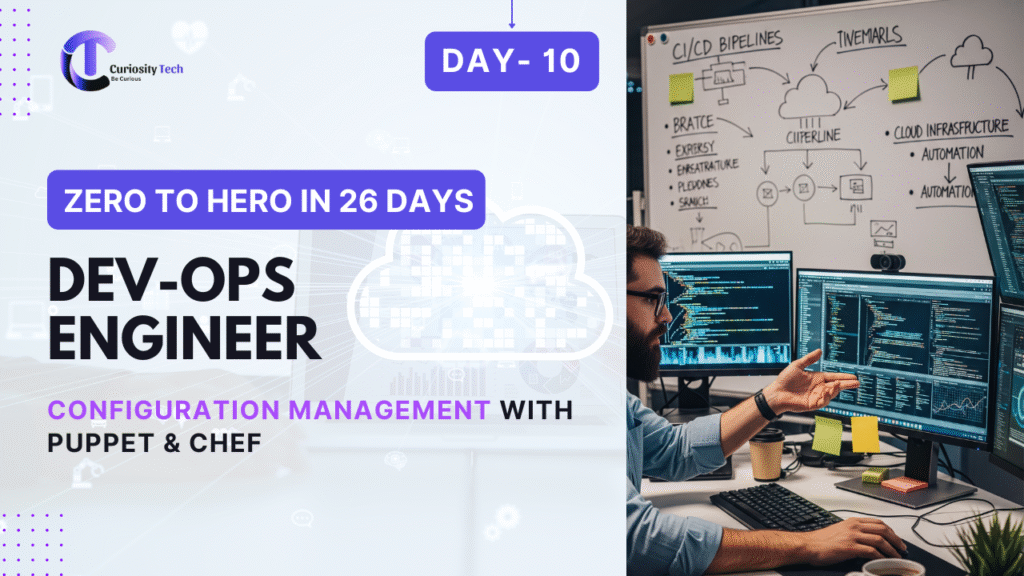In modern DevOps, configuration management (CM) is a foundational practice that ensures systems are consistent, predictable, and maintainable across development, testing, and production environments. Tools like Puppet and Chef automate system configurations, application deployments, and server management, reducing manual errors and increasing operational efficiency. At CuriosityTech.in, we teach DevOps engineers how to master CM tools as part of a complete CI/CD ecosystem.
What is Configuration Management?
Configuration management is the practice of automating system setup, application installation, and environment configuration so that servers and services remain consistent across all environments. CM ensures:
1. Consistency – Every server has the same configuration.
2. Scalability – Rapid provisioning of hundreds or thousands of servers.
3. Auditability – Track configuration changes over time.
4. Compliance – Meet security and operational standards.
CM is critical for enterprises where manual configuration leads to drift, errors, and downtime. Puppet and Chef address this by codifying system states.
Puppet vs Chef Overview
| Feature | Puppet | Chef |
| Type | Declarative | Imperative |
| Language | Puppet DSL | Ruby DSL |
| Architecture | Master-Agent | Master-Agent or Solo Mode |
| Resource Management | Resource-centric, desired state | Task-centric, procedural |
| Community Support | Large, mature ecosystem | Strong, flexible ecosystem |
| Best Use Case | Consistent server configuration | Complex orchestration, application deployment |
Hierarchy Diagram: CM Workflow

Description: Puppet focuses on defining the desired state of servers and ensuring consistency, while Chef executes tasks to reach the desired configuration.
Puppet: Declarative CM Tool
Puppet uses a declarative language to define the desired state of resources like packages, files, and services.
Workflow:
1. Write Manifests – Define resources and desired state in Puppet DSL.
2. Apply Configuration – Puppet agent applies the manifest to nodes.
3. Enforce State – Puppet continuously monitors nodes and ensures compliance.
4. Report – Generates detailed reports for audits and monitoring.
Example Puppet Manifest: Installing Nginx
package { ‘nginx’:
ensure => installed,
}
service { ‘nginx’:
ensure => running,
enable => true,
}
Key Features:
● Idempotent: Re-running manifests does not create errors.
● Centralized management via Puppet Master.
● Extensive module ecosystem for pre-built configurations.
Chef: Imperative CM Tool
Chef is a Ruby-based configuration management tool that uses recipes and cookbooks to automate system setup.
Workflow:
1. Write Cookbooks – Collection of recipes defining tasks and configurations.
2. Run Chef Client – Applies recipes on target nodes.
3. Enforce Configuration – Chef ensures the system executes tasks as defined.
4. Audit and Logging – Track changes and detect drift.
Example Chef Recipe: Installing Nginx
package ‘nginx’ do
action :install
end
service ‘nginx’ do
action [:enable, :start]
end
Key Features:
● Procedural approach for step-by-step task execution.
● Flexibility for complex orchestration.
● Integrates with cloud platforms and CI/CD pipelines.
CM Best Practices
1. Version Control Everything – Store manifests, recipes, and cookbooks in Git.
2. Test Configurations – Use tools like Test-Kitchen or Puppet’s built-in testing framework.
3. Modularize Code – Break large manifests or cookbooks into reusable modules.
4. Use Idempotency – Ensure multiple runs produce the same results without side effects.
5. Integrate with CI/CD – Automate configuration deployment as part of pipelines.
At CuriosityTech.in, learners practice deploying multi-tier applications using Puppet and Chef, combining infrastructure provisioning with application configuration for end-to-end automation.
Challenges & Solutions
| Challenge | Solution |
| Steep Learning Curve | Start with single-node configurations, gradually move to multi-node clusters. |
| Resource Drift | Schedule regular CM runs to maintain desired state. |
| Tool Selection | Choose Puppet for simplicity and compliance, Chef for complex orchestration. |
| Integration with IaC | Combine with Terraform or Ansible to manage infrastructure + configuration. |
Infographic: Puppet & Chef in CI/CD Pipeline




